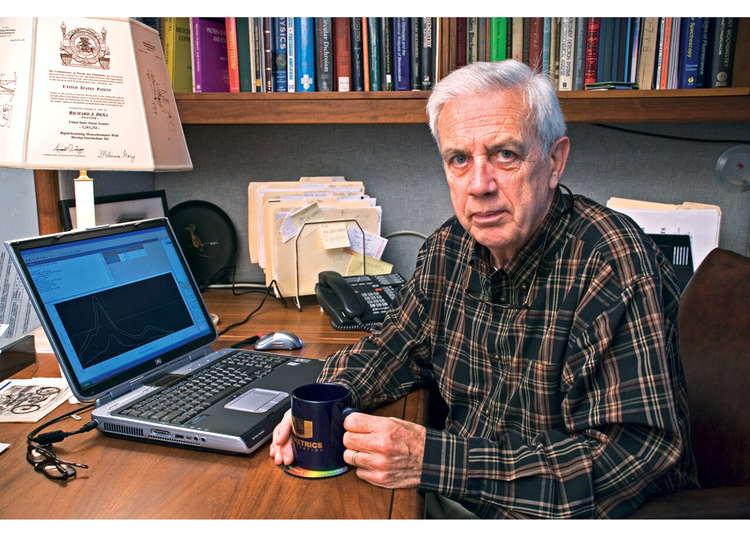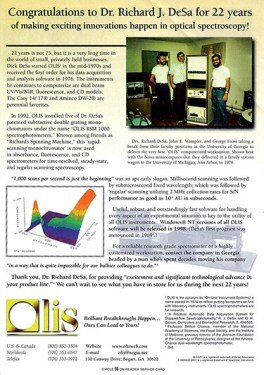The Basic Principles Of Uv/vis/nir
The Of Uv/vis/nir
Table of ContentsNot known Details About Uv/vis An Unbiased View of Uv/vis/nirSome Known Details About Uv/vis/nir Things about SpectrophotometersThe Ultimate Guide To Uv/visThe Definitive Guide for Uv/visThe 6-Second Trick For Circularly Polarized LuminescenceThe 15-Second Trick For SpectrophotometersAbout Circular DichroismUv/vis/nir for DummiesThings about Circular DichroismNot known Facts About Uv/visNot known Details About Circular Dichroism
It is then scanned through the sample and the referral services. Fractions of the incident wavelengths are transferred through, or shown from, the sample and the reference. The resultant light strikes the photodetector gadget, which compares the relative intensity of the 2 beams. Electronic circuits convert the relative currents into direct transmission portions and/or absorbance/concentration values.The transmission of a reference compound is set as a baseline (datum) worth, so the transmission of all other substances are recorded relative to the initial "zeroed" compound. The spectrophotometer then converts the transmission ratio into 'absorbency', the concentration of particular elements of the test sample relative to the preliminary substance.
Considering that samples in these applications are not readily available in big quantities, they are especially fit to being evaluated in this non-destructive technique. In addition, precious sample can be saved by utilizing a micro-volume platform where as low as 1u, L of sample is needed for complete analyses. A quick explanation of the treatment of spectrophotometry includes comparing the absorbency of a blank sample that does not include a colored compound to a sample which contains a colored substance.
The Only Guide to Circularly Polarized Luminescence
In biochemical experiments, a chemical and/or physical home is selected and the treatment that is used specifies to that property in order to derive more details about the sample, such as the amount, purity, enzyme activity, etc. Spectrophotometry can be utilized for a variety of strategies such as identifying optimal wavelength absorbance of samples, identifying optimal p, H for absorbance of samples, identifying concentrations of unidentified samples, and figuring out the p, Ka of different samples.: 21119 Spectrophotometry is likewise a useful procedure for protein purification and can likewise be used as an approach to create optical assays of a compound.
It is possible to understand the concentrations of a two component mixture utilizing the absorption spectra of the standard options of each part. To do this, it is required to know the termination coefficient of this mix at 2 wave lengths and the extinction coefficients of options that include the known weights of the two parts.

The Greatest Guide To Spectrophotometers
Region. The concentration of a protein can be estimated by determining the OD at 280 nm due to the existence of tryptophan, tyrosine and phenylalanine.
This approach needs a spectrophotometer capable of determining in the UV area with quartz cuvettes.: 135 Ultraviolet-visible (UV-vis) spectroscopy involves energy levels that delight electronic transitions. Absorption of UV-vis light excites particles that are in ground-states to their excited-states.
These curves can be used to check a brand-new batch of colorant to check if it makes a match to specs, e
Traditional visible standard noticeable area not detect if a colorant or the base material has fluorescence. This can make it challenging to manage color concerns if for example one or more of the printing inks is fluorescent. There are 2 significant setups for visual spectrum spectrophotometers, d/8 (round) and 0/45.
Researchers use this instrument to measure the amount of substances in a sample. In the case of printing measurements two alternative settings are typically utilized- without/with uv filter to manage much better the result of uv brighteners within the paper stock.
Facts About Uv/vis Uncovered
Some applications need little volume measurements which can be carried out with micro-volume platforms. As explained in the applications section, spectrophotometry can be used in both qualitative and quantitative analysis of DNA, RNA, and proteins. Qualitative analysis can be used and spectrophotometers are utilized to tape-record spectra of substances by scanning broad wavelength regions to figure out the absorbance properties (the intensity of the color) of the substance at each wavelength.

The 9-Second Trick For Circularly Polarized Luminescence
One major element is the type of photosensors that are offered for different spectral regions, but infrared measurement is also difficult since essentially whatever produces IR as thermal radiation, particularly at wavelengths beyond about 5 m. Another issue is that many products such as glass and plastic soak up infrared, making it incompatible as an optical medium.
Samples for IR spectrophotometry might be smeared in between two discs of potassium bromide or ground with potassium bromide and pressed into a pellet. Where aqueous solutions are to be determined, insoluble silver chloride is utilized to construct the cell. Spectroradiometers, which operate almost like the noticeable area spectrophotometers, are created to determine the spectral density of illuminants. 2013. p. 13. Allen, DW; Cooksey, C; Tsai, BK (Nov 13, 2009). "Spectrophotometry". Recovered Dec 23, 2018. Ninfa AJ, Ballou DP, Benore M (2010 ). Basic Lab Methods for Biochemistry and Biotechnology (2nd ed.). Hoboken: Wiley & Sons. ISBN 9780470087664. OCLC 488246403. Schwedt G (1997 ). The necessary guide to analytical chemistry.
Oke, J. B.; Gunn, J. E.
Some Known Factual Statements About Uv/vis

1021/ac50048a728. ISSN0003-2700. Ninfa AJ, Ballou DP, Benore M (2015 ). Fundamental Laboratory Methods for Biochemistry and Biotechnology (3, rev. ed.). Hoboken, NJ: Wiley & Sons. p. 77. ISBN9780470924525. OCLC915641828. "Totally Automatic Double Beam - Atomic Absorption Spectrophotometer (AA 8000)". Lab Equipment. Labindia Analytical Instruments Pvt. Ltd. "Spectrophotometry Applications and Basics".
Little Known Facts About Uv/vis/nir.
Recovered Jul 4, 2018. Trumbo, Toni A.; Schultz, Emeric; Borland, Michael G.; Pugh, Michael Eugene (April 27, 2013). "Applied Spectrophotometry: Analysis of a Biochemical Mix". Biochemistry and Molecular Biology Education. 41 (4 ): 24250. doi:10. 1002/bmb. 20694. PMID 23625877. (PDF). www. mt.com. Mettler-Toledo AG, Analytical. 2016. Retrieved Dec 23, 2018. Cortez, C.; Szepaniuk, A.; Gomes da Silva, L.
"Checking Out Proteins Filtration Methods Animations as Tools for the Biochemistry Mentor". Journal of Biochemistry Education. 8 (2 ): 12. doi:. Garrett RH, Grisham CM (2013 ). Biochemistry. Belmont, CA: Cengage. p. 106. ISBN 978-1133106296. OCLC 801650341. Holiday, Ensor Roslyn (May 27, 1936). "Spectrophotometry of proteins". Biochemical Journal. 30 (10 ): 17951803. doi:10. 1042/bj0301795.
PMID 16746224. Hermannsson, Ptur G.; Vannahme, Christoph; Smith, Cameron L. C.; Srensen, Kristian T.; Kristensen, Anders (2015 ). "Refractive index dispersion noticing using an array of photonic crystal resonant reflectors". Applied Physics Letters. 107 (6 ): 061101. Bibcode:2015 Ap, Ph, L. 107f1101H. doi:10. 1063/1. 4928548. S2CID 62897708. Mavrodineanu R, Schultz JI, Menis O, eds.
Uv/vis/nir Can Be Fun For Everyone
U.S. Department of Commerce National Bureau of Standards unique publication; 378. Washington, D.C.: U.S. National Bureau of Standards.
The procedure starts with a regulated light source that illuminates the analyzed sample. In the case of reflection, as this light communicates with the sample, some is absorbed or released. The released light travels to the detector, which is evaluated, measured, and presented as industry-standard color scales and indices.
All terms are evaluated over the noticeable spectrum from 400 to 700 nm. In the case of transmission, when the light engages with the sample, it is either taken in, reflected, or sent.
Uv/vis Can Be Fun For Anyone
Examples consist of APHA (American Public Health Association) for watercolor and purity analysis, ASTM D1500 for petrochemical color analysis, edible oil indices utilized in food, and color analyses of beverages. All terms are evaluated over the noticeable spectrum from 400 to 700 nm.
Image Credit: Matej Kastelic/ Dr. Arnold J. Beckman and his coworkers at the National Technologies Laboratories initially created the spectrophotometer in 1940. In 1935 Beckman established the business, and the discovery of the spectrophotometer was their most ground-breaking creation. Dr. Bruce Merrifield, a Nobel prize-winning biochemist, specified that the invention of the spectrophotometer was "most likely the most important instrument ever established towards the development of bioscience." Before the discovery of the spectrophotometer, chemical analyses took weeks to finish, with 25% precision.
Rumored Buzz on Uv/vis
Over time, researchers kept improving the spectrophotometer style to improve its performance. The UV abilities of the model B spectrophotometer were enhanced by replacing the glass prism with a quartz prism.
After 1984, double-beam versions of the device were designed. The addition of external software with the arrangement of onscreen display screens of the spectra was available in the 1990s. Generally, a spectrophotometer is comprised of 2 instruments, namely, a spectrometer and a photometer. A standard spectrophotometer contains a light source, a monochromator, a collimator for straight beam transmission, a cuvette to place a sample, and a photoelectric detector.
Indicators on Spectrophotometers You Need To Know
There are various types of spectrophotometers in different shapes and sizes, each with its own purpose or performance. A spectrophotometer determines just how much light is reflected by chemical elements. spectrophotometers. It measures the distinction in light intensity based on the overall amount of light introduced to a sample and the quantity of beam that goes through the sample option
A spectrophotometer is utilized to determine the concentration of both colorless and colored solutes in an option. This instrument is utilized to identify the rate of a reaction.